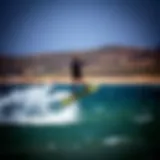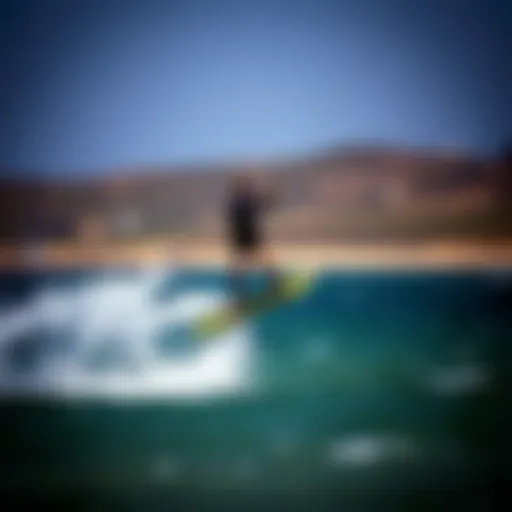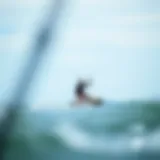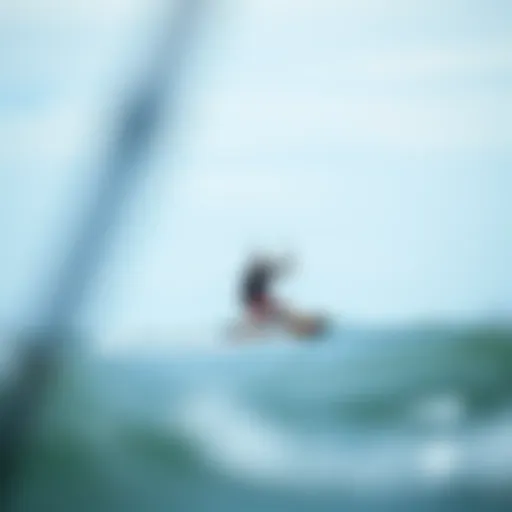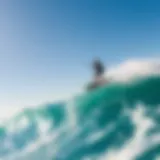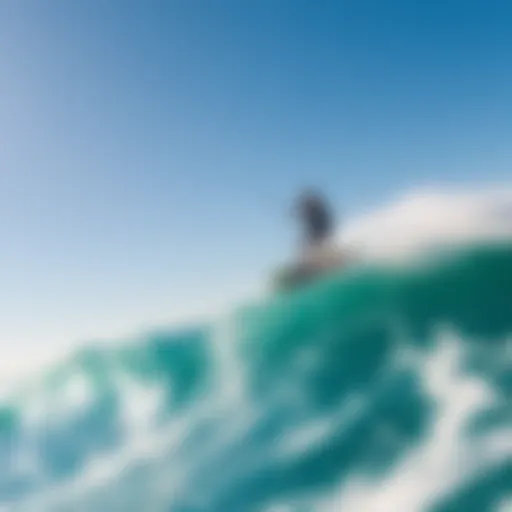Navigating the Kite Wing Market: Essential Insights


Intro
Kite wings have taken the world by storm, transforming the way enthusiasts engage with the winds and waters. From adrenalin junkies chasing the waves to those seeking leisure on a scenic beach, kite wings offer exhilarating experiences across various skill levels. As interest in this sport surges, understanding the market for kite wings has never been more crucial. With advancements in technology and materials, the options can feel as vast as the horizon itself, making it paramount for enthusiasts, be it beginners or seasoned kiteboarders, to get a grip on what’s currently available.
In this guide, we aim to bridge the gap between curiosity and knowledge. Let’s cut through the jargon and get down to brass tacks by exploring the types of kite wings, their performance capabilities, and the overall market landscape, ensuring that every kite enthusiast can make informed choices for their gear purchases.
Expect to dive deeper into gear insights, from the latest reviews to essential equipment for beginners. Moreover, we will touch on techniques complemented by tips to refine your abilities, all while advocating for safety practices to ensure everyone enjoys their time out on the water.
With all that said, let's wind up our discussion and get into some of the nitty-gritty details to elevate your kite wing experience!
Foreword to Kite Wings
The world of kite wings is vast and ever-evolving, marking a significant niche within the broader realm of water sports and adventure recreation. Kite wings, designed for harnessing the power of the wind, have transformed the way enthusiasts experience water and snow. Their importance goes beyond just being a vessel for gliding; they represent freedom, thrill, and technological advances that keep pushing the boundaries of what is possible in aerial sports.
Defining the Kite Wing
At their essence, kite wings are specialized devices used to glide through the air while being pulled by wind. Typically, they come in two main forms: foil kite wings and inflatable kite wings.
- Foil Kite Wings: These employ an airfoil design, which generates lift when wind flows over them. They are lightweight and favored by more advanced users who seek speed and maneuverability.
- Inflatable Kite Wings: These are easier to handle for beginners. They come inflated and provide great stability and control in various wind conditions.
The defining characteristics of a kite wing include its size, shape, and construction material, all of which play a crucial role in performance and user experience. A proper fit ensures that the kite wing delivers the desired power and control, enabling riders to navigate waves or perform tricks with grace.
Evolution of Kite Wing Technology
The evolution of kite wing technology is nothing short of fascinating. Beginning from early designs that were mere fabric and string, innovative engineering has led to high-performance models that integrate cutting-edge materials and designs.
Originally influenced by traditional kiting and paragliding, modern kite wings now utilize specialized fabrics and materials like ripstop nylon. These advancements have resulted in designs that not only enhance performance but also improve safety features.
Some notable milestones in the evolution include:
- Material Advances: The introduction of lighter, stronger materials has resulted in wings that can withstand harsh conditions while maintaining performance.
- Design Innovations: The shift from flat to three-dimensional shapes has increased lift and reduced drag, further enhancing speed and responsiveness.
- Control Systems: Modern kite wings come equipped with intricate control systems that make them easier to handle, allowing riders at all skill levels to enjoy the benefits of kite winging.
As technology continues to improve, we see kite wings becoming increasingly versatile, catering to various environments—be it ocean, lakes, or snow-covered landscapes. The ongoing innovation in design and functionality helps users stay safe while pushing the limits of their kite wing adventures.
The Kite Wing Market Landscape
Understanding the dynamics of the kite wing market is crucial for anyone looking to dive into the world of kiteboarding or kiting in general. The market landscape reveals a lot about the existing trends, consumer preferences, and innovations that shape the future of kite wings. By examining this landscape, enthusiasts can make informed decisions regarding their gear, ensuring they select kite wings that best suit their style, skill level, and budget. The kite wing market is not just a collection of products; it reflects a community that embraces adventure and skillful performance on the water or land.
Current Trends in Kite Wings
The kite wing market is currently evolving at a rapid pace, reflecting advancements in both technology and consumer preferences. One notable trend is the increasing popularity of lightweight materials. Manufacturers are focusing on creating wings that don’t just perform well but are also easy to handle, making them friendly for beginners and seasoned riders alike. Another trend has been the rise of hybrid designs. Many kite wings now feature a blend of characteristics from traditional kites and surf wings, enhancing versatility.
Consumers are also becoming more environmentally conscious. As such, brands are actively promoting sustainable practices in their production processes. Options made from eco-friendly materials are gaining traction, appealing to those who want to enjoy their sport while being kind to the planet. Additionally, customization options are on the rise. Riders can now personalize their kite wings to suit their aesthetic tastes and performance needs, fostering a deeper connection between the rider and their gear.
"The kite wing market is not just about the gear, but also about the community spirit that supports innovation and sustainability."
Key Manufacturers and Brands
When navigating the kite wing market, it's important to know key players who are shaping the industry with their innovations and offerings. Some notable brands include:
- Duotone: A staple in the kiteboarding community, Duotone is known for its high-performance kite wings that cater to a range of skill levels. Their wings focus on durability and performance, making them a must-see in the market.
- F-One: This brand has made a name by blending cutting-edge technology with stylish designs. Their kite wings are appreciated for their control and stability in varying wind conditions.
- Ozone: Ozone is celebrated for its commitment to quality and performance. Their range of wings includes options for beginners to advanced riders, showcasing adaptability in design and usage.
- Naish: A long-standing name in the kiteboarding world. Naish offers wings that are known for their robustness in extreme conditions, perfect for adventurous kiteboarders.
- Slingshot: Committed to innovating kite design, Slingshot's wings are often lauded for their innovative features. Riders love the way these wings handle various wind conditions, providing a fun experience.
These manufacturers not only contribute to the growth of the kite wing market but also to the advancement of technology and design that enhance the overall kiting experience. Understanding who is behind the gear can provide insights into the quality and reliability of the products available.
Types of Kite Wings Available
Understanding the different types of kite wings available on the market is crucial for anyone looking to dive into the world of kiteboarding. This section sheds light on two prominent categories of kite wings: foil kite wings and inflatable kite wings. Each type has distinct characteristics, advantages, and drawbacks, making them suitable for varying riding styles and conditions.
Foil Kite Wings
Foil kite wings are designed with a system of internal cells that air fills, creating a shape much like an airplane wing. This design gives them several advantages, which are especially noticeable in specific conditions.


- Lightweight and Compact: Foil wings are typically lighter than their inflatable counterparts. This characteristic makes them easy to carry around, especially if you're traveling or hiking to windy locations.
- Efficiency in Low Wind: They perform remarkably well in lighter winds, which can be a significant benefit for those in regions where wind speeds are often inconsistent. For instance, if you find yourself on a lake with gentle breezes, a foil wing can help you catch those currents effectively.
- Exciting Performance: Offering great precision in flight, foil wings allow for sharper turns and quicker responses. They can deliver an exhilarating experience for those who enjoy agility in their ride.
Despite these benefits, there are some considerations:
- Need for Skill: They can require a bit more technique to use effectively, which might not suit beginners who are just starting.
- Limited Use in High Wind: In gusty conditions, they might not perform as well and can be tricky to control if the winds kick up.
In summary, foil kite wings can be an excellent choice for the lightweight adventurer and those riding in tranquil wind conditions. They combine efficiency and performance to offer a thrilling experience.
Inflatable Kite Wings
Inflatable kite wings, on the other hand, rely on a series of inflatable bladders to maintain their shape. This design brings its own unique set of features.
- Stability and Predictability: Inflatable wings tend to offer more stability in varying wind conditions, making them ideal for both novice and experienced riders. Riders can count on the predictable behavior of these wings when the wind shifts or blows heavier.
- User Friendly: With a forgiving nature, these wings are often more beginner-friendly. Their predictable lift and easy relaunch capabilities allow new riders to learn with less frustration.
- Versatility: Inflatable wings are generally adaptable to a range of conditions, from strong winds to calm days. Whether you plan to ride on flat waters or rough sea conditions, these wings can hold their own.
However, they do come with some downsides:
- Weight Consideration: Inflatable kite wings can be heavier due to the additional materials needed for their construction. Carrying longer distances could be a hassle for some.
- Setup Time: Inflation can take some time, which is something to factor into your beach days. While this might not be a dealbreaker, it is something to be aware of.
Inflatable kite wings serve those looking for reliability and ease of use, making them an excellent entry point for beginners as well as satisfying for experienced riders seeking versatility.
Key Features to Consider When Buying a Kite Wing
When contemplating the purchase of a kite wing, understanding the essential features that influence performance can be as crucial as picking the right swell for a surf session. The right kite wing not only elevates your experience but also enhances your skills and safety on the water. Diving deep into aspects like size, shape, material composition, and bridle system design will help you make the right decision for your specific riding style and conditions.
Size and Shape
The size and shape of a kite wing directly impact how it functions in different wind conditions. A larger wing can catch more wind, providing more lift and power, which is especially beneficial for beginners seeking stability. However, this size also means more drag, making it more challenging to maneuver. Conversely, a smaller wing is easier to control but requires stronger winds to perform optimally.
When choosing a size, consider the typical wind conditions where you’ll be riding. For instance, in breezy coastal areas, a larger wing may serve you well, while in gustier conditions, a smaller, more agile wing could be the ticket.
Additionally, the shape of the kite wing affects its performance characteristics. Wings with a high aspect ratio (long and narrow) tend to offer better speed and efficiency, making them suited for experienced riders. On the other hand, a lower aspect ratio provides more stability and is more forgiving for novice users.
Material Composition
Kite wings are often made from a variety of fabrics, each with unique properties that affect durability, weight, and performance. Common materials include polyester and ripstop nylon. Polyester is cheaper and can handle rough conditions but may not last as long as nylon, which is lightweight and resistant to tearing, making it a popular choice for high-performance wings.
When evaluating material composition, weigh the trade-offs. A lightweight material may enhance your wing's responsiveness, but it also might not withstand rough handling. Look for wings with reinforced seams and robust stitching, as these can add longevity and peace of mind while you’re out on the water.
Bridle System Design
The bridle system functions as the backbone of kite wing control, linking the wing to the rider’s control system. An effective bridle system can significantly enhance maneuverability and stability. Different designs, like the simple 2-line or more complex 4-line setups, offer varying degrees of performance and ease of use.
For beginners, a bridle system that is easy to adjust can help fine-tune performance as wind conditions change. As you advance, you might appreciate a more intricate bridle design that allows for more precise tuning and responsiveness. This means the kite reacts better to shifts in pressure and can perform tricks with greater ease.
In summary, scrutinizing these key features—size and shape, material composition, and bridle system design—will help you navigate the myriad of options and ensure that your investment aligns with your skill level and riding aspirations.
"Choosing the right kite wing is like picking the right partner for an adventure—harmonize your choices with your experience and surround yourself with the right energy."
When selecting a kite wing, remember that the devil is in the details. Each aspect plays a role in how the kite performs and ultimately feels while riding.
Pricing Dynamics in the Kite Wing Market
Understanding the pricing dynamics in the kite wing market is crucial for anyone considering making a purchase. The price of a kite wing not only reflects its material qualities and manufacturing processes but also the level of technology and performance it offers. Kite wings come in a range of prices due to various factors, such as brand reputation, innovation, and the design features integrated into each model. Grasping how these elements contribute to pricing can aid buyers in making informed decisions that align with their budget and skill level.
Affordable Options for Beginners
For those just dipping their toes into kiteboarding, finding a quality yet affordable kite wing is pivotal. Beginners often seek options that won’t break the bank but still provide decent performance. Here are some affordable kite wings that newbie riders might consider:
- KiteWing Basic: This model has sturdy construction with simplified features, designed with the novice in mind.
- FlySurfer Soul: It’s known for its reliability and is a great introductory option without overwhelming first-time users.
- Ozone Wasp: This wing balances performance and price, giving newcomers a chance to explore different conditions while not exceeding their budget.
When choosing an affordable kite wing, beginners should think about the following:
- Durability: Look for wings with strong materials; they may withstand crashes and rough handling better.
- User-Friendly Design: Features like easy inflation and intuitive controls can enhance the learning experience.
- Reputation of the Manufacturer: Established brands may offer better customer support and warranties, adding value to the purchase.


Premium Kite Wings for Advanced Users
As skills develop, many kiteboarders might feel the urge to upgrade to premium kite wings that offer better performance and enhanced features. These wings are often designed with advanced materials such as ripstop nylon or lightweight composites that maximize speed and handling. Some top premium wings in the market include:
- North Reach: Known for its performance in diverse wind conditions, it’s favored by many competitive riders.
- Duotone Echo: This wing has a great lift-to-drag ratio, making it suitable for high-speed maneuvers and advanced tricks.
- Naish S26: Offers customizable setups for performance tuning, which can significantly enhance responsiveness for seasoned riders.
When investing in premium kite wings, practitioners should consider:
- Performance Features: Elements like wingtip designs for better stability and optimized materials can greatly affect performance outcomes.
- Sales and Discounts: Keep an eye on sales or off-season discounts, which can make high-quality wings more accessible without compromising on features.
- Resale Value: Higher-end wings often maintain better resale values; this is something to keep in mind for future upgrades.
"Investing in the right kite wing from the start can drastically enrich your kiteboarding experience as you progress."
Where to Buy Kite Wings
Finding the right place to purchase kite wings is a crucial element in your kiteboarding journey. This decision can significantly affect your experience—both on the water and in terms of your pocketbook. Whether you are a seasoned rider or taking your first steps in the world of kite wings, knowing where to buy can tip the scale toward a successful experience. Understanding the options between local shops and online retailers, as well as how to evaluate the credibility of these sources, can save you time and potential headaches.
Local Shops Versus Online Retailers
When you think about buying kite wings, the choice between local shops and online retailers often comes up. Each avenue has its unique perks.
- Local Shops: Here, you get the chance to physically inspect the products. You can engage with knowledgeable staff who might provide insights from personal experiences. Plus, trying before you buy is a luxury you don't often find online. These shops often have demo wings available, so you can test them out—like trying on shoes before buying. They might also foster a sense of community, enabling you to connect with local riders and instructors who can share tips.
- Online Retailers: The internet opens up a world of options. You can compare prices quickly and find deals that may not be available in brick-and-mortar stores. Online shops often have a wider variety of brands, types, and price ranges at your convenience. However, make sure to check the shipping costs and return policies. It’s essential to read the fine print, as purchasing online carries risks; what looks good in a picture may not perform the same way once it’s in your hands.
Both avenues have their merits, and the right choice depends on your individual needs. If you value personal interaction and local expertise, head to a shop nearby. However, if variety and price are your priority, exploring the digital market may be your best bet.
Evaluating Retailer Credibility
Regardless of where you choose to make a purchase, ensuring the retailer is reputable is key. Here are some factors to consider when evaluating the credibility of a kite wing retailer:
- Customer Reviews: Platforms like Reddit and specialized kiteboarding forums often contain reviews from actual customers. Their experience can provide invaluable insight.
- Return Policies: A clear and fair return policy speaks volumes about a retailer’s confidence in their products. If they stand by what they sell, they’re likely worth considering.
- Expertise: Look for retailers who specialize in kiteboarding gear. Their staff should have a breadth of knowledge and be able to answer technical questions. If it feels like you're speaking to a wall, it might be a sign to look elsewhere.
- Warranty and Repairs: A credible retailer will offer warranties and services for repairing any defects. This reassures you that your investment is protected.
- Social Media Presence: A strong social media presence often indicates that a retailer is engaged with its customers. Look at their platforms for feedback and community interactions.
In summary, buying kite wings shouldn’t be a shot in the dark. Take the time to research and assess your options wisely, whether you opt for the charm of a local store or the breadth of an online marketplace.
"Knowledge is power. Equip yourself before you step out on the water."
Be sure to check forums such as Reddit for discussions on gear and retailer experiences, and consider guidance from your local kiteboarding community.
User Reviews and Recommendations
User reviews and recommendations serve as a vital compass for buyers navigating the kite wing market. In an industry where personal experience and performance can vary widely, insights from fellow riders provide a clearer picture. These reviews not only offer anecdotal wisdom but can highlight specifics that might not make it onto the product specifications.
Evaluating user feedback can uncover critical aspects like durability, ease of use, and overall performance under different conditions. Additionally, recommendations from seasoned kiteboarders can guide newcomers, helping them to avoid the pitfalls of purchasing a kite wing that isn't well suited for their skill level or the type of conditions they wish to ride in.
"Hearing from someone who has already tested the gear in the wild gives you peace of mind before making a splurge on something as crucial as your kite wing."
Insights from Experienced Riders
When it comes to understanding the kite wing market, insights from those who’ve been around the block can be incredibly valuable. Experienced riders often spill their thoughts on various attributes and performance metrics that matter most. This can include feedback on lift, maneuverability, and responsiveness, which are pivotal traits for a good kite wing.
Riders who frequent different locations often share how certain wings perform better in specific environments—like coastal waters versus lake conditions. They might mention how certain brands handle gusty winds compared to more stable, calmer scenarios. To fathom the nuances, consider browsing dedicated kiteboarding forums—like reddit.com/r/kiteboarding—to find engaging discussions about personal experiences, as well as comparisons between brands.
What New Users Should Look For
For beginners entering the kite wing market, it’s crucial to know what to prioritize when selecting a wing. Here are some key considerations:
- Skill Level Compatibility: Choose kite wings designed for beginners, which are often more forgiving and easier to control.
- Size Recommendations: Get a size that matches your weight and skill—smaller wings can be more difficult to handle initially.
- Material Quality: Look for durable materials that withstand wear and tear, especially since beginners may not yet have the finesse to be gentle with their gear.
- Customer Reviews: Utilize platforms like facebook.com/groups/kiteboarding to ask questions and gauge opinions from other newcomers.
By focusing on these factors, new users can carve a pathway toward making informed choices. Seeking community feedback and recommendations can help demystify the fears of entering the kite wing arena, ensuring a much smoother ride as they build confidence and skill.
Maintenance and Care for Kite Wings
Caring for your kite wings may not be the most exciting aspect of kiteboarding, but it’s absolutely essential. Proper maintenance can significantly extend the lifespan of your gear and ensure that your kite performs at its best when you need it the most. Everything from regular cleaning to understanding how to properly store your kite can make a world of difference. It’s not just about protecting your investment; it’s about maintaining the quality of your riding experiences.
Storage Practices
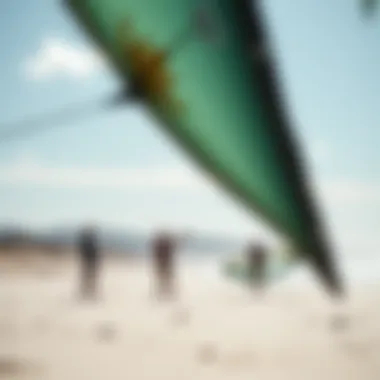
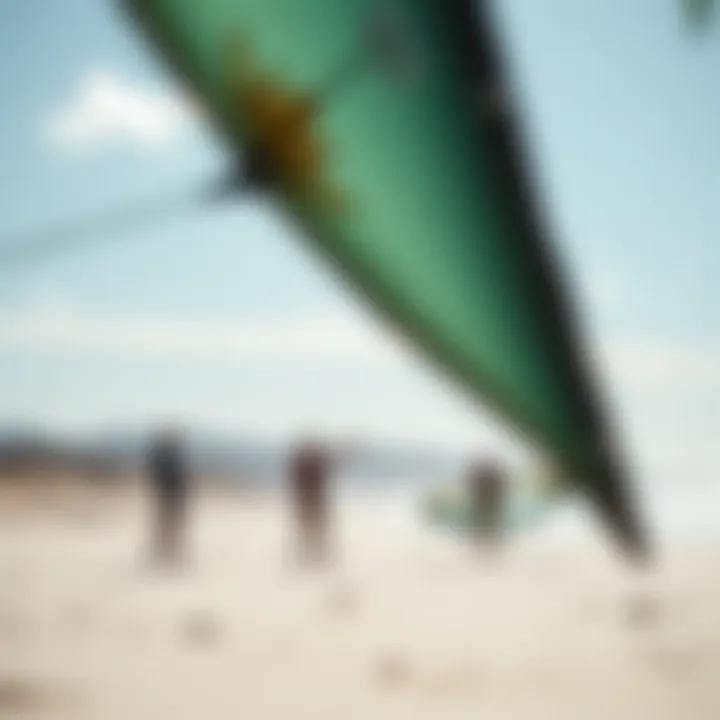
Where and how you store your kite wings plays a crucial role in preventing wear and tear. Ideally, you want to keep them in a cool, dry place, away from direct sunlight, as UV rays can weaken the fabric over time. Here are a few tips to consider for storage:
- Use a Dedicated Bag: Invest in a good quality kite bag. Not only does it protect the kite from dust and moisture, but it also makes transportation a whole lot easier.
- Proper Folding: When storing, fold your kite neatly instead of just stuffing it in the bag. This helps to prevent creasing and potential damage to the fabric.
- Avoid Sharp Objects: Keep your kite away from tools or equipment that might have sharp edges. They can easily puncture your kite without you even realizing it.
"Proper storage can mean the difference between a fantastic session and a frustrating day on the water. Treat your gear with respect."
Repairing Common Damages
Damage can happen, even to the best of us. Whether it's a small tear or a more significant issue, knowing how to repair your kite wings can save you both time and money.
- Small Tears: For minor rips or tears, a repair patch specifically designed for kites can work wonders. First, clean the area thoroughly to remove any dirt, then apply the patch as instructed.
- Punctures: These can be a bit trickier. A temporary fix is to use a piece of tape on both sides of the material, but for a solid repair, consider sewing the fabric together, if you're comfortable with that.
- Bridle Lines: If your bridle line frays, replace it immediately. A compromised bridle can lead to catastrophic failures while kiteboarding.
Performing consistent care will not only help your kite wings last longer but also ensure that they perform correctly. It’s all about creating good habits that make the sport more enjoyable in the long run.
Following these maintenance tips will keep your kite reliable and ready for the next adventure. Whether you’re a seasoned pro or a weekend warrior, taking a little time each season to care for your kite will pay dividends in every ride.
Future Directions in Kite Wing Development
In the world of kite wings, the winds of change are constantly blowing. As outdoor enthusiasts continue to seek out new thrills and improved gear, the future of kite wings promises to be increasingly innovative. This section takes a closer look at emerging technologies and sustainability efforts shaping the landscape of kite wing production. Understanding these elements is not just a foresight but a necessity for those looking to stay ahead in the game, whether you're an instructor, a seasoned rider, or simply someone with a hankering for adventure.
Emerging Technologies
The kite wing market shows signs of rapid advancement, with several cutting-edge technologies taking flight. These innovations are designed not just to enhance performance but also to simplify the user experience. Some key developments include:
- Smart Wing Systems: With integration of sensors capable of measuring wind speed and direction, these systems adjust the wing shape in real-time for optimal performance. Imagine a wing that learns your riding style and adapts itself; that's the future here.
- Improved Materials: New composites are lighter and more durable, which can drastically affect performance. For instance, some manufacturers are experimenting with ripstop nylon blended with polyethylene to create wings that both glide seamlessly and resist wear.
- Enhanced Safety Features: Innovations like automatic depower systems ensure that riders have fewer worries about what might happen if things go awry.
These technologies foster a more dynamic riding experience, pushing the boundaries of what kite wings can achieve.
"The future of kite wings isn’t just in the air; it’s in the data!"
Sustainability Efforts in Production
While the thrill of kiteboarding is undeniable, the environmental impact of production methods can put a damper on the excitement. Fortunately, sustainability is becoming a focal point for many manufacturers. They are now exploring eco-friendly practices, which encompass both materials and processes.
- Recycled Materials: More brands are turning to recycled plastics and fabrics. These greener options help reduce the carbon footprint associated with production.
- Biodegradable Components: Innovations in material science are resulting in parts that break down naturally after their lifecycle, minimizing waste in landfills.
- Energy-efficient Manufacturing: By employing renewable energy sources for production, companies are not only cutting costs but also supporting the planet.
By paying attention to these sustainability efforts, kite wing enthusiasts can contribute positively to the environment while enjoying a beloved sport.
The future of kite wings is poised to be not only more exciting but also more responsible.
Final Thoughts on Kite Wings
Kite wings represent a unique intersection of skill, adventure, and technology. When it comes down to choosing the right wing for your kiteboarding experience, it's not just about picking the flashiest design or the most talked-about brand. The decision has a significant impact on the overall enjoyment and success of your time on the water.
Understanding the nuances of kite wings can make all the difference. There are several aspects to consider, including the type of wing, its size, shape, and the materials used in its construction. Each feature contributes to the performance of the kite, influencing things like stability, speed, and ease of handling. These factors are crucial when determining which kite wing aligns with your personal style and skill level.
In addition to performance features, acknowledging your environment is pivotal. Different kite wings perform optimally under various wind conditions and water surfaces; therefore, knowing your local conditions enables you to select the right gear. A wing that excels in gusty conditions might be less forgiving in calmer winds. Understanding this landscape ensures that your choice is not just a shot in the dark.
Building Confidence in Your Purchase
When investing in a kite wing, confidence is key. The importance of thorough research cannot be overstated. Before making a purchase, take the time to analyze user reviews, technical specifications, and expert recommendations. This diligence fosters a sense of security about your choice.
- Know Your Needs: Start by identifying what you want. Are you chasing thrills with high-speed rides, or are you seeking a smooth and steady experience?
- Test Before Buying: If possible, getting hands-on experience can prove invaluable. Many shops offer demo days or test rides, allowing you to feel the difference between models.
- Seek Community Guidance: Engaging with groups on platforms like reddit.com can provide insights that are often absent in sales pitches.
Building confidence in your purchase forms a foundation for a fulfilling relationship with your kiteing gear.
Enjoying the Kiteboarding Experience
Kiteboarding is not just about the gear; it’s about the experience itself. A well-chosen kite wing enriches your time on the water, transforming each outing into a memorable adventure. When your equipment fits well, performs efficiently, and resonates with your abilities, the joy multiplies.
- Connect with Nature: A good kite wing allows you to harness the wind, leading to exhilarating rides and a deeper connection with your surroundings.
- Community and Culture: Kiteboarding often brings like-minded individuals together. Sharing experiences, tips, and stories creates a sense of camaraderie that enhances your overall experience.
- Skill Development: Well-suited equipment can accelerate your skill progression. As you build confidence and capability, the sport becomes increasingly rewarding.
The thrill that comes with kiteboarding, underpinned by an understanding of your kite wing, fosters joy and encourages a lifelong passion. Investing time into researching and selecting your gear translates into a richer, more satisfying experience on the water.
"When you invest in gear that matches your style and skill, every session becomes a joyful journey across the waters."
For those looking to delve deeper into the specific technologies of kite wings and even more user insights, resources such as Wikipedia provide a wealth of information. Additionally, connecting with communities on platforms like Facebook can also offer invaluable support and guidance.
Kite wings are more than just objects; they are integral parts of your adventure. By carefully considering your options and fostering confidence in your choices, you set the stage for an enriching kiteboarding experience.
